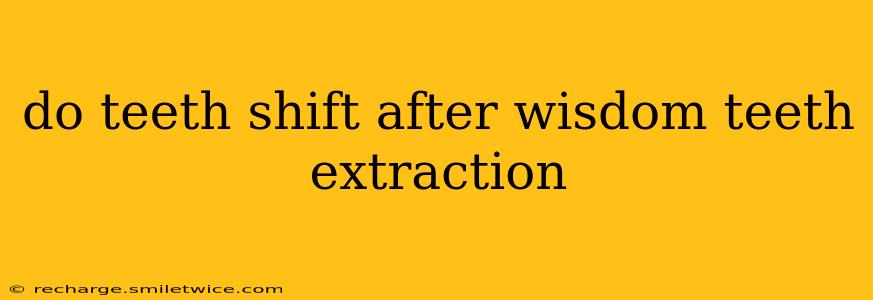Do Teeth Shift After Wisdom Teeth Extraction? A Comprehensive Guide
The extraction of wisdom teeth, those final molars at the back of your mouth, is a common procedure. But a question many patients have is: will my teeth shift after the extraction? The short answer is: yes, it's possible. The extent of shifting depends on several factors, and understanding these factors is crucial for managing expectations and ensuring optimal post-extraction care.
Why Do Teeth Shift After Wisdom Teeth Removal?
Teeth are constantly under pressure from surrounding muscles and tissues. When wisdom teeth are removed, the space they occupied becomes vacant. This creates an imbalance in the forces acting on the adjacent teeth, leading them to potentially shift. This shifting isn't always dramatic; it can be subtle and gradual. Think of it like dominoes—removing one piece can affect the alignment of others.
What Factors Influence Tooth Shifting After Wisdom Tooth Extraction?
Several factors play a significant role in determining the likelihood and extent of tooth movement post-extraction:
- The amount of space left after extraction: If a significant gap is left after wisdom tooth removal, the adjacent teeth are more likely to shift into the empty space. Conversely, minimal space reduces the likelihood of significant shifting.
- The age of the patient: Younger individuals typically experience more significant tooth movement than older adults due to more flexible jaw bones and periodontal ligaments.
- The presence of other orthodontic issues: Pre-existing misalignments or crowding can exacerbate the shifting process. Patients with already crowded teeth may see more pronounced movement after wisdom tooth removal.
- The type of extraction: Simple extractions (where the tooth is removed relatively easily) may result in less shifting than surgical extractions (where the tooth is impacted and requires more extensive surgical intervention).
- Post-extraction care: Diligent adherence to post-operative instructions, including maintaining proper oral hygiene, can significantly influence the healing process and reduce the likelihood of complications, potentially minimizing tooth movement.
- The use of post-extraction retainers: Your dentist or oral surgeon might recommend wearing retainers after wisdom tooth extraction to help stabilize the surrounding teeth and prevent significant shifting.
How Significant is the Shifting?
The degree of tooth movement varies greatly. Some individuals may experience minimal or no noticeable shift, while others might see more significant changes in alignment. In many cases, the shift is subtle and only detectable through dental X-rays or professional examination. In rare cases, substantial movement might necessitate further orthodontic treatment.
What Can I Do to Prevent Significant Tooth Shifting?
While you can't entirely prevent some degree of tooth movement, these measures can help minimize it:
- Follow your dentist's post-operative instructions carefully: This includes meticulous oral hygiene and avoiding activities that could disrupt the healing process.
- Consider wearing a retainer: Your dentist may recommend a retainer to help stabilize the teeth in their current positions.
- Attend regular check-up appointments: Monitoring your teeth after wisdom tooth extraction allows your dentist to detect any significant changes early and recommend necessary intervention.
Do I Need Orthodontic Treatment After Wisdom Tooth Extraction?
Orthodontic treatment after wisdom tooth extraction isn't always necessary. However, if significant tooth shifting occurs, impacting your bite or causing aesthetic concerns, your dentist may recommend braces or aligners to correct the misalignment.
In conclusion, while some degree of tooth shifting after wisdom tooth extraction is possible, it's not inevitable. By understanding the contributing factors and adhering to your dentist's recommendations, you can minimize the risk of significant movement and maintain a healthy, well-aligned smile. Remember, proactive communication with your dentist is key throughout this process.
